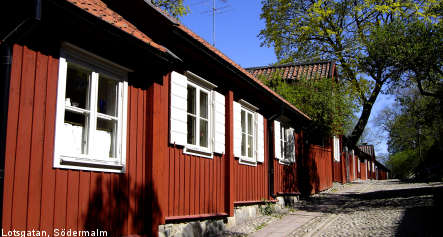What’s the most underrated thing in Stockholm?
The area around Katarina Church on Södermalm. It’s full of red wooden houses and quaint narrow streets, but gets very little space in the guidebooks compared to Gamla Stan (the Old Town)- and is pretty free of tourists as a result. It also has beautiful views of the Old Town, Djurgården and the Baltic ferries.
What’s the most popular request from tourists?
Most people want to get away from the tourist traps, so when I take people to Gamla Stan we get off the busy streets like Västerlånggatan and walk through the backstreets. There are lots of hidden treasures there, such as the ‘Järnpojke’ sculpture. The name means ‘Iron Boy’ and it was erected in 1967. For the past couple of decades locals have taken to dressing him up – giving him a hat in winter and putting a flower in his hand in the summer. They’ve even given him the name ‘Olle’- he’s a bit of an Old Town institution.
What else do people ask about?
Many people – younger tourists in particular – are more interested in learning about how ordinary Swedes live than learning about history. I get a lot of questions about how the property market works and how much people earn. In a similar vein, I now sometimes take people on tours of Hammarby Sjöstad – many French people have heard about this amazing new eco-town and want to see it for themselves. It’s actually a really interesting part of the city.
What’s the best museum in Stockholm?
The Vasa Museum, without a doubt – it’s so impressive. Every time I go in there I still think ‘Wow’. The whole history behind it is fascinating, too – the ship managed to get less than 2 kilometres before sinking. It was then raised from the water 333 years after sinking, which is incredible.
Where’s a good place to buy a good piece of Swedish design?
Nordiska Galleriet on Östermalm is has great Swedish furniture. For smaller, gadgety things, head to Design Torget or Stockhome.
French tourists can have high culinary standards – where do you advise them to eat?
It’s true that tourists from France can be picky – I had one couple who complained to me every day about the food in their luxury hotel. Then they went to a restaurant one day and they were served pasta with sausage, which left them pretty unimpressed. The places they loved were Pontus by the Sea in Stockholm and Waxholms Hotell, which is out in the archipelago. For less expensive food, I usually advise people to head for the Östermalm district or to the area around Medborgarplatsen on Södermalm. One place I find people like to eat lunch on Östermalm is Örtagården, which has a terrace overlooking Saluhallen, the market hall. For lunch on Sunday I’d recommend the Grand Hotel or the restaurant at Moderna Museet – but make sure you book ahead.
And for a drink?
East on Stureplan is a good place to go if you want to dress up and people-watch. Otherwise, I really like the Tudor Arms on Grevgatan in Östermalm – a great place to go for a beer.



 Please whitelist us to continue reading.
Please whitelist us to continue reading.